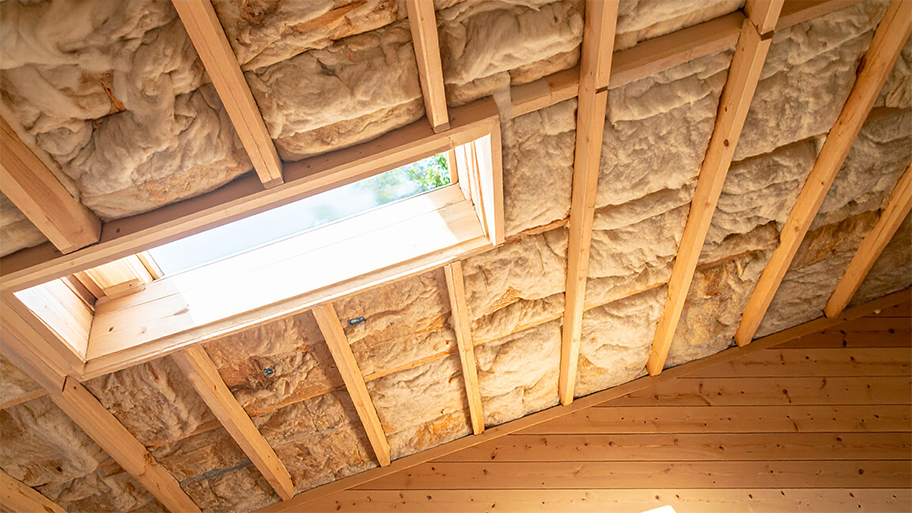
Insulating your attic can massively improve your home’s efficiency and reduce electric bills. Use this guide to find out what attic insulation will cost you.
Attic insulation keeps heat where it should be


Properly installed attic insulation could increase your home’s heat by five to 20 degrees Fahrenheit.
Installing attic insulation costs $2,100 on average.
Having a professional inspect and install the insulation delivers the best results.
Keeping your home at a consistent, comfortable temperature doesn’t have to involve cranking up your furnace or air conditioner and hoping for the best when you open the monthly energy bill. Installing attic insulation is a proven commodity for maintaining a more consistent temperature without using more energy. How much does attic insulation help with temperature regulation? Up to 20 degrees Fahrenheit of benefit is common with a well-insulated attic compared to one without insulation.
Using insulation in the attic helps you maintain more consistent temperatures in your home compared to not having enough or any insulation. Attic insulation creates a thermal barrier that inhibits the climate-controlled air in your home from mixing with the non-climate-controlled air in the attic.
Most homes experience an increase of 5 to 20 degrees Fahrenheit after installing attic insulation. It prevents heat loss through the ceiling into the attic during winter and stops heat penetration from the attic through the ceiling into the home during summer.
If you experience a 10-degree improvement after installing insulation compared to when you didn’t have attic insulation, your furnace or air conditioner doesn’t have to work as hard. Without insulation, your HVAC system was working harder—and using more energy—to try to make up that 10 degrees to keep your home comfortable.
According to the EPA, homeowners can save significantly on monthly heating and cooling bills by installing insulation in their attics, floors, and crawl spaces.
On hot summer days when the sun heats up the attic space, insulation greatly slows the transfer of that heat into your main living space. With less heat entering from the attic, your air conditioner doesn’t need as much energy to maintain a consistent, cool temperature in the home.
Because heat rises, attic insulation is even more important during winter. When you heat your home in winter with a furnace or heat pump, the heat rises and tries to escape through the attic.
Attic spaces cool quickly during cold winter weather. Heat from inside your home would move upward quickly to replace the cool attic air unless insulation in the attic is providing a barrier. The insulation holds more heat inside the home, allowing the furnace to run less often and consume less fuel.

To add insulation to an attic, you could do the job yourself with certain types of insulation. However, it’s often easier to have a professional do the work to ensure you have the right depth and material for your attic’s needs.
The best person to install insulation at your home is an experienced attic insulation professional near you. This expert can inspect your attic and determine what depth of insulation is appropriate. They can also give you an attic insulation cost estimate, but most homeowners pay an average of $2,100.
A professional installer can also ensure you don’t have too much insulation in the attic. If you haphazardly add more insulation to the attic yourself to try to save on energy costs and end up with too much, you can trap excess moisture in the space. If you have poor attic ventilation along with too much insulation, it could lead to mold and mildew growth.
Relying on a pro for an inspection and the installation gives you the best chance of success with this job.
According to Angi data, 54% of homeowners report having blown-in insulation in their attics. Other common locations for this essential home insulation are inside the walls and ceilings.
Spray foam insulation is widely considered the best insulation for an attic, as it offers an excellent thermal barrier. The liquid application process easily fills in any gaps in an odd-shaped attic, keeping heat transfer at a minimum.
However, spray foam insulation can be expensive to install. Some people will select a lower-cost alternative, like fiberglass insulation. Fiberglass is highly effective in an attic, too, but it may not deliver the complete coverage that spray foam offers.
Blown-in insulation is another alternative to spray foam, providing good energy efficiency for older homes. The loose material can fit into small crevices and even repel insects.
A professional insulation installer can look for signs of poor insulation in a home or attic and recommend the best insulation material.
From average costs to expert advice, get all the answers you need to get your job done.

Insulating your attic can massively improve your home’s efficiency and reduce electric bills. Use this guide to find out what attic insulation will cost you.

How much does a radiant barrier cost? Our guide breaks down prices by type of barrier and size of your attic space.

Crawl space insulation costs vary by size, insulation type, and material. Read this guide to learn how much your crawl space insulation could cost.

Learn everything you need to know about mineral wool insulation when selecting the insulation with the best R-value for your home.

Find out the average pipe insulation cost, including material and labor prices, plus tips to save money on your project.

When comparing fiberglass insulation versus foam board, each has certain areas where it works better. Learn more about these home insulation options.